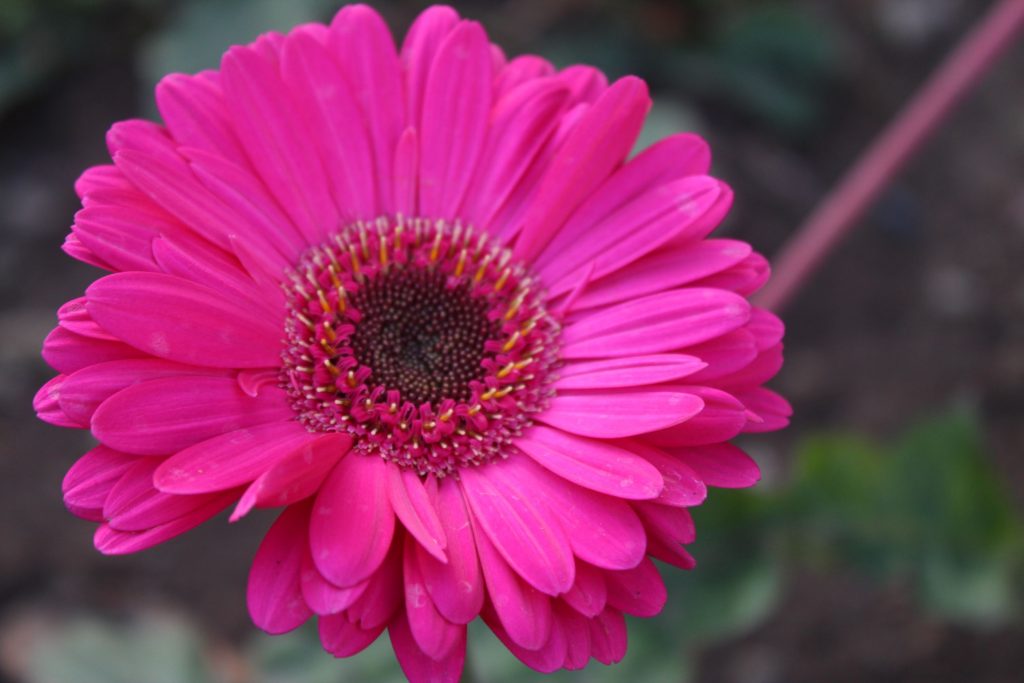Gerbera is a genus of the family of sunflowers, Daisies and Asters – Asteraceae, with a wide distribution from Africa to Madagascar, tropical Asia and South America. The genus name, Gerbera was named in honor of the 18th-century German naturalist, Traugott Gerbera.
Gerberas is a very popular perennial flowering plant which is widely used as a decorative garden plant or as cut flowers.
Through hybridization, Gerberas are available in a massive array of colors. Gerbera daisies have long-lasting 3- to 4-inch flowers that come in numerous shades of yellow, white, pink, red, orange, lavender, salmon, and bicolored. The center floral disk can range from a yellowish to light-bronze to black in color. Gerberas produce flowers from late spring through autumn in the garden, and their blooms make long-lasting cut flowers. Gerbera daisies typically grow 6 to 18 inches tall. There are four different classes of gerbera daisies: a single flower, semi-double flower, double flowers, and spider flowers. Each class delineates the number, position, and type of petals. The leaves of the plant are lobed or pinnate and often toothed.
featuring a large capitulum with striking, 2-lipped ray florets. The capitulum on the Gerberas has the appearance of a single flower, but is actually a cluster of hundreds of individual flowers. The morphology of the flowers varies depending on their position in the capitulum of the Gerberas.

GROWING GERBERA DAISIES
Plant them in the late spring, after the danger of frost has passed.
Choose a bright place where the seeds will get about 8 hour of indirect light every day. Poke a hole about 6mm deep in the soil. Drop a seed in each hole with the pointed end facing down. The top of the seed should be just below the soil line and water them. As the seeds germinate, water as necessary to keep the soil slightly moist but not soggy. The first blooms will appear 18 to 24 weeks after sowing.
PLANT CARE
LIGHT
Gerberas grow best in areas that receive plenty of sunlight (at least 6-8 hours a day), but they don’t like intense heat. In warmer climates, plant them in a spot that provides some afternoon shade.
SOIL
Plant in compost-rich, well-drained, slightly acidic soil (pH of 5.5 to 6.5). Good soil drainage is important to avoid crown and root rot. If you have heavy clay soil, consider growing your gerberas in containers with a high-quality potting mix.


SPACING
Space plants 12 to 18 inches apart to ensure good air flow.
WATER
Water regularly until plants become well established, keeping the soil evenly moist but not soggy. Once established, water the plants when the surface of the soil feels dry to the touch, but be careful not to oversaturate the soil, which can lead to crown and root rot.
MULCH
Apply a layer of organic mulch around your plants to help conserve soil moisture, but be careful not to cover the crowns.
FERTILIZING
To keep your gerberas flowering vigorously all season, feed them with a water-soluble organic fertilizer every two weeks or with a slow-release granular plant food applied several times during the growing season. Potted plants may need more frequent feedings.
PRUNING
To encourage optimal flowering, remove spent blooms as soon as they fade, cutting the stalks back to the base of the plant. Also keep your plant tidy by removing withered or damaged leaves.
PROPAGATING GERBERAS
Gerberas tend to be short-lived, but the plants are easy to propagate by dividing them in the spring or fall or by taking stem cuttings after your plants finish flowering. Unless you plan to let your plants self-sow, divide them every two or three years to extend their lifespan.
